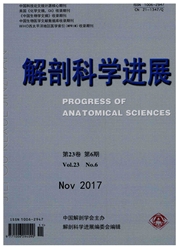

 中文摘要:
中文摘要:
目的观察创伤后应激障碍(PTSD)样行为异常大鼠杏仁核神经元CaM依赖性蛋白激酶IIα(CaMKIIα)及磷酸化CaM依赖性蛋白激酶IIα(pCaMKIIα)表达变化。方法采用国际认定的SPS方法刺激建立大鼠PTSD模型,取成年健康雄性Wistar大鼠75只,随机分为SPS模型的12h、1d、4d、7d组及正常对照组,采用免疫组织化学、免疫印迹法检测大鼠杏仁核CaMKIIα及pCaMKIIα的表达变化。结果SPS刺激后大鼠杏仁核神经元细胞内CaMKIIα于12h开始减少,1d表达最少,4d开始逐渐增多,至7d时基本恢复正常;pCaMKIIα的表达则于SPS12h开始增多,1d时表达最多,4d时开始减少,至7d时基本恢复正常。CaMKIIα阳性细胞在SPS各组模型均出现,1d表达最少。结论杏仁核CaMKIIα及pCaMKIIα的表达变化,可能是PTSD大鼠情感行为异常的重要病理生理基础之一。
 英文摘要:
英文摘要:
Objective To observe the changes of CaMKII α and pCaMKII α expression in the amygdala neurons of posttraumatic stress disorder(PTSD) rats to explore the pathogensis of PTSD. Methods The SPS-method was used to set up the rat PTSD models. A total of 75 male Wistar rats were randomly divided into12h, 1d, 4d, 7d groups of single prolonged stress(SPS) and normal control group. The expression of CaMKIIα and pCaMKIIα as detected using immunohistochemistry and western blotting. Results The expression of CaMKII α in the amygdala of rats was decreased 12h after SPS stimulation, and reached the lowest at ld after SPS, began to recover 4 days and to normal 7 days. However, the expression of pCaMKII α was increased 12h after SPS stimulation, and peaked at ld after SPS, and began to decrease 4 days and to normal level after SPS stimulation. The CaMKII α positive cells were detected in each SPS models and reached the lowest at ld after SPS. Conclusion The changes of expression of CaMKII α and pCaMKII α in the amygdala of PTSD rats may be related to the pathogenesis of PTSD.
 同期刊论文项目
同期刊论文项目
 同项目期刊论文
同项目期刊论文
 Single-prolonged stress induces apoptosis in the amygdala in a rat model of post-traumatic stress di
Single-prolonged stress induces apoptosis in the amygdala in a rat model of post-traumatic stress di Activitity of the 5-HT 1A receptor is involved in the alteration of glucocorticoid receptor in hippo
Activitity of the 5-HT 1A receptor is involved in the alteration of glucocorticoid receptor in hippo Increased phosphorylation of extracellular signal-regulated kinase in the medial prefrontal cortex o
Increased phosphorylation of extracellular signal-regulated kinase in the medial prefrontal cortex o Changes of Bax, Bcl- 2 and apoptosis in hippocampus in the rat model of post-traumatic stress disord
Changes of Bax, Bcl- 2 and apoptosis in hippocampus in the rat model of post-traumatic stress disord 期刊信息
期刊信息
